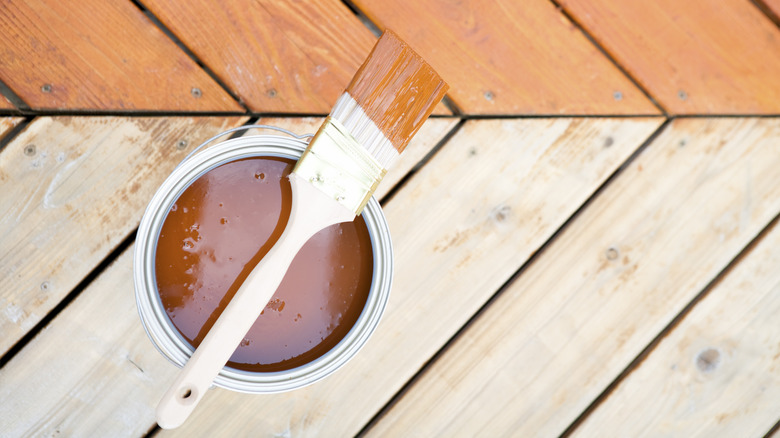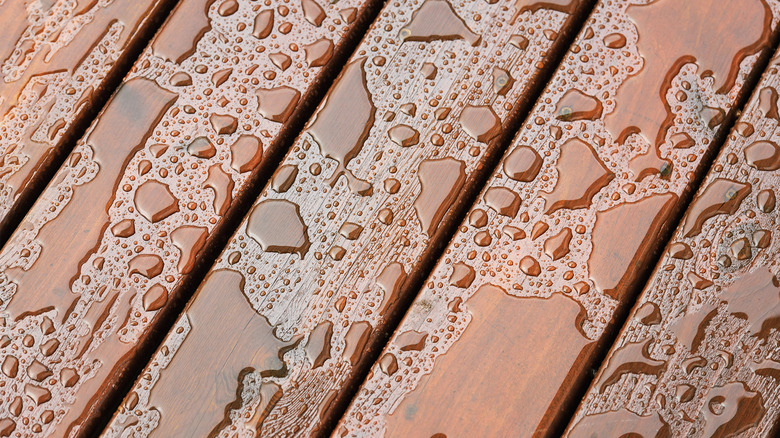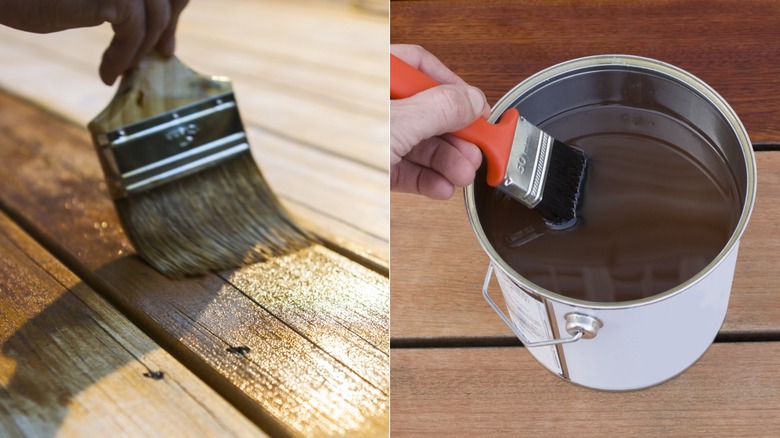Deck Stain Vs Sealer: What's The Difference And Which Is Best For Your Deck?
Building a deck in your backyard is one outdoor update that can add serious value to your home. That is, if you maintain it properly. Otherwise, it can turn into one of those unsightly eyesores that your neighbors secretly hate about your hard. Deck maintenance starts right at the get-go — during installation, with various considerations like timing playing crucial roles. For example, did you know that winter is actually an ideal time to build a deck? Did you also know that following installation, it is crucial that you stain and seal your deck?
Sealing and staining are imperative in extending your deck's lifespan post-installation, especially considering most decks are crafted from wood. Exposed to the elements, wood faces inevitable wear and tear. Sealing and staining act as protective shields, preventing moisture from seeping in and enhancing the durability of your deck.
But what distinguishes sealing from staining, and which is best for your deck? Read on to discover the nuances of deck sealing versus staining so that you can discern the best approach for your deck's needs.
What is deck stain?
Deck stain is a pigmented coating that can enhance the aesthetic of your deck. But it doesn't just cover the surface. It penetrates into your deck's wooden fibers, providing a crucial protective element for your deck. Unlike paint, which merely forms a thick layer on the surface of your wood, the deck stain will seep deep into each wooden panel. This helps preserve the natural grain and texture of your deck.
Deck stains come in various formulations, each offering unique levels of color coverage and protection. Transparent stains are ideal for those seeking a natural, rustic look that allows the wood's inherent beauty to shine through. On the other hand, solid or opaque stains provide complete coverage, effectively hiding the wood's natural grain for a more uniform appearance. Of course, there are also semi-transparent options available, offering a balance between transparency and coverage to suit your preferences.
Regardless of the formulation you choose, all deck stains will provide essential protection against environmental damage from UV rays, moisture, and even things like wear and tear from foot traffic. By penetrating the wood fibers, stains create a durable barrier that prolongs the life of your deck and maintains its aesthetic appeal for years to come.
What is deck sealant?
Deck sealant, or sealer, is another type of protective coating applied to wooden decks to safeguard them against environmental damage and wear. Unlike deck stain, which adds color to the wood, sealant primarily acts as a clear or tinted barrier that seals the wood surface.
Deck sealants come in two primary types: water-based and oil-based. Water-based sealants are popular for their quick drying time, low odor, and ease of cleanup. On the other hand, oil-based sealants offer deeper penetration, providing enhanced protection and a richer finish. However, they typically require longer drying times and stronger ventilation during application.
Deck sealant offers a lot of the primary benefits that deck stain does. This includes protection against UV rays, which can cause fading and discoloration of the wood over time, as well as protection from water and moisture, which can lead to rot, mold, and mildew growth, as well as warping and cracking. However, sealants typically offer a greater degree of protection from external elements than stains do.
Is stain or sealant better for my deck?
Since stains and sealants offer similar types of protection, when should you choose which? Well, if you're satisfied with the appearance of your deck's wood, it's perfectly fine to skip a stain and use only a sealant. If you'd like to change the coloring or aesthetic of your deck, however, use a stain. Their pigmentation can help you enhance the visual appeal of your deck. Even if you do stain, always follow up with a sealant since sealants offer a higher degree of protection, and your deck can completely wear down if you don't seal it.
Over time, the need to stain and seal your deck is almost inevitable. This is due to natural wear and tear, which inevitably causes a deck's colors to degrade, so restoring your deck's visual appeal will be a crucial part of maintenance. In these cases, always stain your deck first, then seal. This way, you will seal your desired color into your deck.
Stains and seals can be applied to decks every two to three years, depending on the quality of the wood, the products used, and how they hold up to the elements over time. While the process can be arduous, the benefits to your deck are significant. Fortunately, many home and garden stores offer two-in-one stains and sealers these days. These innovative products not only save time and effort but also spare your knees by streamlining the maintenance process.



